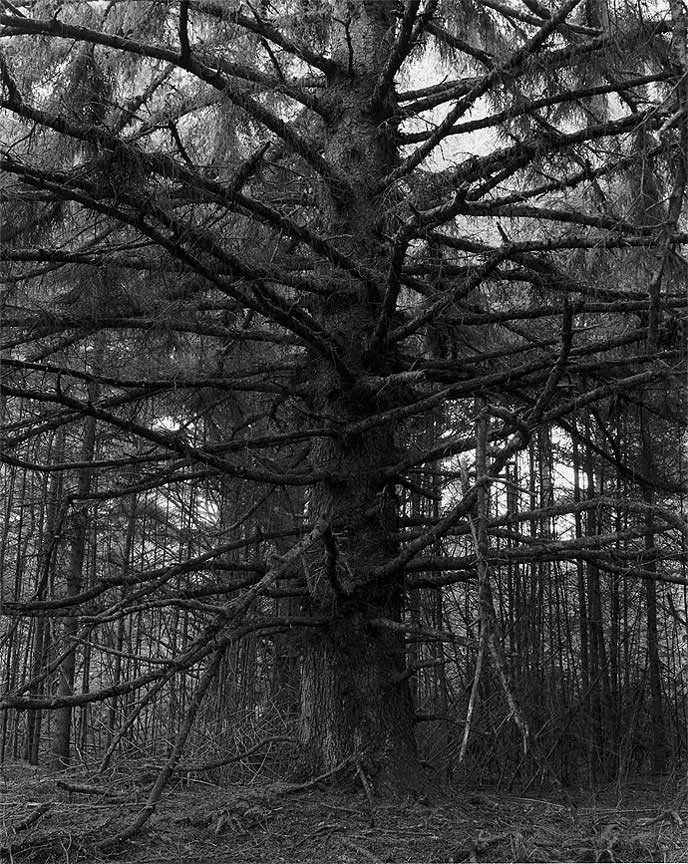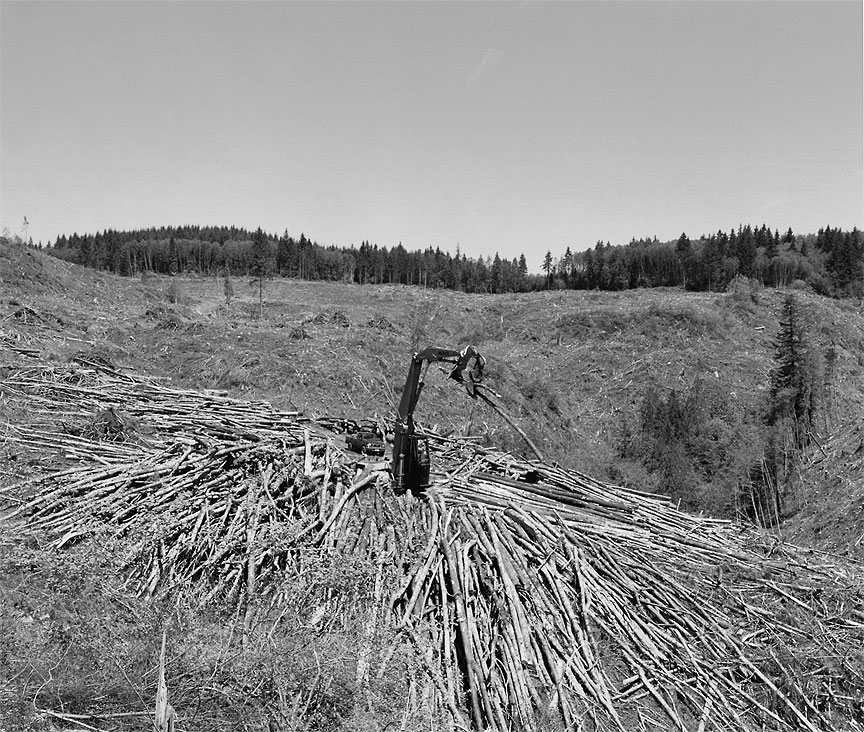Interview
“Turning Back”

Robert Adams. Sitka Spruce, Cape Blanco State Park, Curry County, Oregon, 1999-2003. From the series Turning Back. Gelatin silver print; 14 x 11 inches. © Robert Adams. Courtesy Fraenkel Gallery, San Francisco and Matthew Marks Gallery, New York.
Robert Adams discusses his 2005 book of photography, Turning Back: A Photographic Journal of Re-Exploration.
ART21Can you talk about your book, Turning Back?
ADAMSThe book is fundamentally about deforestation in the Northwest. And as such it’s a grim journey. I nonetheless believe that one is obliged to try to find an affirmation, even in tough circumstances. And so, the book concludes, having gone through the coast range of Oregon and the deforestation that’s there. There’s a clump of poplar trunks, pretty much clear to the horizon, that stands at a crossroads. We spent about eight hours over two days photographing this tree in different kinds of light, at different hours. And this was a new thing for me: we enlisted the help of a plate maker to make four gravures of the trunks. It’s my stab at trying to say, “It’s not all over.” Granted, one poplar is not a replacement for the rain forest that once lined the Oregon and Washington coasts, but it’s minority evidence in favor of hope. And I think we don’t pay attention to that kind of thing, at our peril.
ART21The book takes you on a kind of a journey…
ADAMSThe book basically starts at the ocean, goes through the industrial forest land where there used to be a rain forest, and ends on the high deserts of Oregon. It ends in a small town where Kerstin and I were unexpectedly befriended by a person we did not know, who invited us to stay in her house, which we did for some time. She had about ten acres in this valley called Pine Valley. And, sad to say, we returned there the following year and while we were there, a catastrophe struck. Perhaps I should just read the text: “As it happened, we were in Hathaway on September 11, 2001. For a time thereafter, we found it impossible to focus on any but those events, so we returned home early. Clear-cutting appears to me to be what most of us see in the world most of the time. There are not many people as kind as our benefactor in Hathaway and not many places as whole. Of what significance is minority evidence? Photography is inherently fragmentary, and I find I base my faith on perfect moments, moments like this. It’s the quality of those moments that weighs in and finally, I think, wins out over the quantity of bad times.”
ART21How has spending time in Oregon changed your work?
ADAMSWhen we moved to Oregon, I spent time continuing what I’d begun in the ’90s, which was to photograph westward, toward the ocean, and basically to photograph what is conventionally beautiful. And it was great. I think I discovered a few ways to refresh the subject a little. But as we approached the bicentennial year of the Lewis and Clark expedition, I began to ask myself, where is the frontier? Is it to the west or the east? And clearly the answer has to be: the frontier now is to the east. And I would submit to you that it’s just as dangerous as the western direction used to be. So, it seemed to me that, on the occasion of the bicentennial, the real job was to remind people what we’re up against now: having to return and look at our own creation and try to correct it, value it, so that we create the country we thought we were creating as we went west but neglected to do the right things. Looking west is what Lewis and Clark did throughout their journey. And then they stood on the beach and continued to look west, I assume. As it happened, when Lewis and Clark turned to go back [east], that’s when they began to make mistakes. They killed at least one or two Indians. One [member] of the party took a needlessly risky side trip. And then, as you know, one of the leaders (they think Lewis) committed suicide. It seems to me that we are now compelled to recognize that we have no place to go but where we’ve been. We’ve got to go look at what we’ve done, which is oftentimes pretty awful, and see if we can’t make of this place a civilized home. We’ve in a sense built a house, but we haven’t made it a home. I’m told that Pete Seeger gives us a 50/50 chance of being here at all in a hundred years. That’s probably a rather generous estimate. But if we’re still here, job number one is clearly to learn how to get along with each other and live richer, more peaceful lives—richer in spirit.

Robert Adams. Stacking the de-limbed trunks of an immature ’harvest,’ Columbia County, Oregon, 1999-2003. From the series Turning Back. Gelatin silver print; 11 × 14 inches. © Robert Adams. Courtesy Fraenkel Gallery, San Francisco and Matthew Marks Gallery, New York.
ART21Why make such a big deal over trees?
ADAMSThe importance of what’s going on in terms of clear-cutting is that there is no indication that this can go on forever. If you turn the globe, you see a history of deforestation that changed societies and from which there has not been, in many cases, a complete recovery—in some cases, no recovery at all. The nub of it is that if you keep cutting (and bear in mind that the cutting now is sustained by the use of artificial herbicides and fertilizers), the soil is eroded more and more. It’s a major contributor to global warming. I think it’s also a terrible example of violence and heedlessness to offer to each new generation. If you don’t care about what your grandchildren and their children are going to inherit, what do you care about? I’m not just concerned with a beer can on a stump. I’m concerned with the disappearance of one of the world’s great rain forests. It’s not just a matter of biology or of exhaustion of resources. I do think there is involved an exhaustion of spirit. I can see it amidst my fellow citizens here in this small town and in this region. They go to great lengths not to visit and not to confront what is happening. And I think from that accrue other cases of cultivated blindness, civically.
ART21Sometimes it’s hard for people to see the bigger picture…
ADAMSI am deeply disturbed that the only thing we want to really get concerned about is something we can quantify, something we can put in terms of dollars and cents. Every one of us knows that the things that are most important to us cannot be measured in that way. So, if you haven’t loved a tree enough (if not to hug it, at least to want to walk up to it and touch it as if you’re touching a profound mystery)—if that experience has eluded you—I feel bad for you because you’re not going to live a happy life. The thing that distresses me most is that there appears to be no likelihood that we’re going to do it. We appear to have the best legislature that money can buy. Twice since we’ve lived here, there have been attempts to stop this by initiative. One would have applied regulations prohibiting clear-cutting throughout the state. That lost—80 percent [against] to 20 percent [for]—after a television blitz in the last couple of weeks [before the vote] that cost millions of dollars and for which the proponents of limitation had no financial recourse. My own belief is that you cannot have a democracy if you don’t give everyone the right to get to the podium. Capitalism is locked in a death struggle with democracy, and capitalism is winning. The second effort was more recent and much more limited. The proposal was to limit to 50 percent what could be clear-cut in two state-owned forests. That’s all they wanted: Just don’t clear-cut half of two state-owned forests. That too went down to defeat—60 percent [against] to 40 percent [for]—again, after a TV blitz for which there could be no answer. It isn’t that there aren’t large numbers of people who want to see ecocide stopped, but the question is whether our political system as it is combined with the economic system is going to allow that to happen.
Art21: Where have things gone wrong? Do you see any hope for change?
ADAMSThomas Jefferson said that you can’t have democracy if you don’t have an effective education system. And that, I think, is the core of what has gone wrong—combined with the economic structure. Our educational system is in a free fall. And unless we can teach children how to resist the devastation worked by what they see on television, advertisements, we’re never going to be able to protect ourselves.



